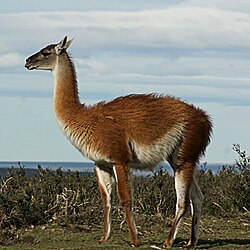Camelids, like horses, went extinct in North America approximately twelve thousand years ago. At that time, there were two camelid species present in Canada. One of them was a large camel known as the western camel, Camelops hesternus. The other was a large llama known as the stilt-legged llama, Hemiauchenia macrocephala. The western camel could be found across Canada, while the stilt-legged llama was found only in the plains and prairie areas of the south.
The western camel was very similar to today's bactrian and dromedary camels, at least in size and skeletal anatomy. It is unknown whether they had humps, but it was roughly the same size as modern camels, if a little larger. Their teeth suggest that like camels, they were browsers that fed on leaves, brush, and shrub plants. Camelops used to be thought of as a large llama species. However, recent studies have shown them to be much more closely related to modern camels. This similarity means that modern camels might easily become ecological surrogates for the western camel. There are three living species of camel, two domestic and one wild. The two domestic species are the dromedary (Camelus dromedarius) and the bactrian (Camelus bactrianus). The dromedary, or one-humped camel, is found in North Africa, Arabia, and the southern Middle-East, and is adapted to extreme desert conditions. The bactrian, or two-humped camel, is found across central Asia and is adapted to more steppe-like habitats. The third, and most promising, is the wild two-humped camel (Camelus ferus) of northern China and Mongolia.
Either of the two-humped camel species could serve as proxies for the western camel in Canada, due to their ability to withstand extremely low temperatures. Either would help to control shrub and sprout plants that bison, antelope, horses, and deer are not likely to eat. The preferable option is to use the wild camels, due to their experience with predators and finding forage. What makes this difficult is the fact that the wild camel is critically endangered, with only about a thousand left in existence, roughly six hundred in Mongolia and four hundred in China. Despite having a decent birth rate, these populations are threatened by poaching, habitat loss, and excessive predation on young by wolves whose populations have been raised by laws that prevent livestock farmers from shooting them. This low population might make assembling a founder population difficult. However, the promise of vast stretches of empty land mostly free of poachers might offer a tempting opportunity for wild camels to increase their population, and offer a backup in case the Asian population is compromised. At the start of such an endeavor, camels could be contained in a fenced area where predators have been removed, in order to allow the population to grow unhindered. The wild camel is capable of surviving in both very low and very high temperatures and so should be able to survive in a multitude of Canadian environments.
The stilt-legged llama was about fifty to seventy-five percent larger than it's South American cousins. It' dental characteristics suggest that it had a similar diet, but based on the locations it has been unearthed from it does not seem that it was a mountainous animal like it's cousins. Like modern llamas, it had an adaptable diet, both browsing and grazing depending on the location and time of year. With the size being the biggest difference, any of the modern llamine species would probably be adequate ecological proxies. These would include the two wild species and two domestic species. The two wild species are the vicuna (Vicugna vicugna) and the guanaco (Lama guanicoe), and their domestic equivalents are the alpaca (Vicugna pacos) and the llama (Llama glama).
The wild species are preferable for rewilding and luckily neither is endangered. Either would be adequate but each has it's own benefits that might make it more suitable. While the vicuna is more well-adapted to cold climates due to it's high altitude lifestyle, the guanaco has a more variable diet, a less mountainous lifestyle, and is closer in size to the stilt-legged llama. This adds up to make guanacos possibly more adequate as proxies for Hemiauchenia macrocephala. However, there are already areas of the Andes where vicunas and guanacos can be found in the same place, seemingly without hybridization or any other sort of interaction. This means that both could conceivably be used in the same places if deemed necessary. It might be advisable to only use guanacos because vicunas, being more inclined towards high altitudes, might end up competing with mountain sheep (Ovis canadensis and Ovis dalli) and mountain goats (Oreamnos americana) rather than acting as ecological proxy to Hemiauchenia.
Top to Bottom:
Lama guanicoe - https://upload.wikimedia.org/wikipedia/commons/thumb/8/8e/Guanaco_09.24.jpg/250px-Guanaco_09.24.jpg
Vicugna vicugna - https://upload.wikimedia.org/wikipedia/commons/e/eb/Vicunacrop.jpg


Great article, your choice of camelids and reasons make great sense, just as wood bison have a small backup population in Siberian, a backup wild bactrian camel population in Canada would be a positive strategy; are there any wild bactrian camels in captivity?
ReplyDeleteI believe there were a few in California but I do not onow for sure, definately a few breeding preserves in Mongolia though, similar to Przewalski's horse. It would be a difficult endeavor to be sure, but I would prefer it to using domestic bactrians though they might be almost as suitable.
Delete